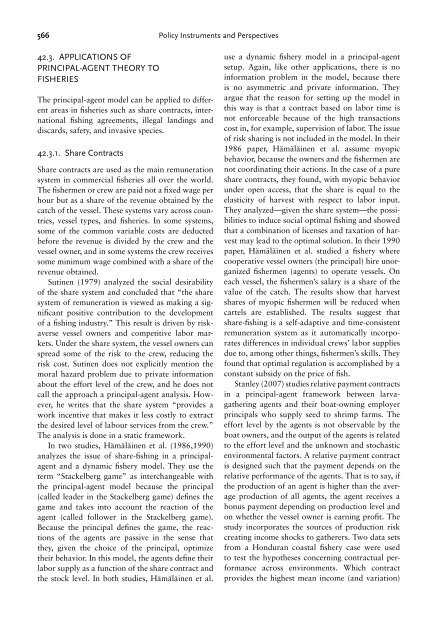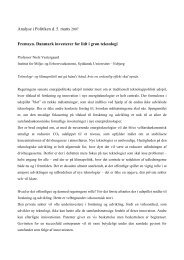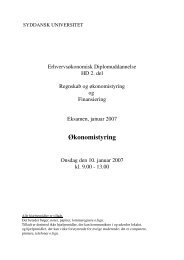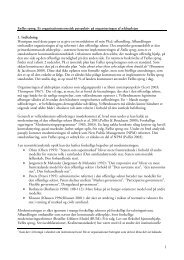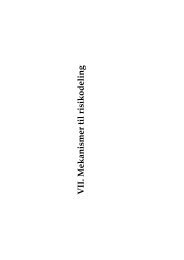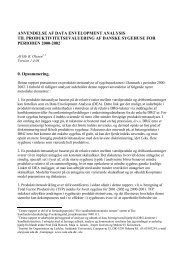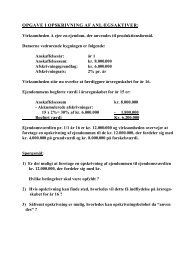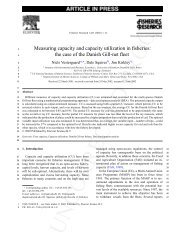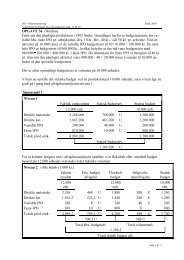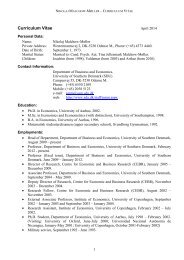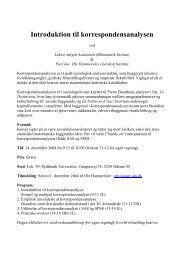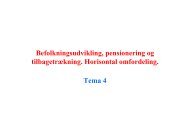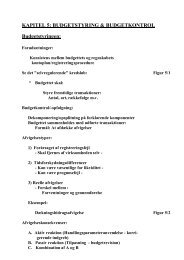Principal-Agent Problems in Fisheries - lah@sam.sdu.dk
Principal-Agent Problems in Fisheries - lah@sam.sdu.dk
Principal-Agent Problems in Fisheries - lah@sam.sdu.dk
Create successful ePaper yourself
Turn your PDF publications into a flip-book with our unique Google optimized e-Paper software.
566Policy Instruments and Perspectives42.3. APPLICATIONS OFPRINCIPAL-AGENT THEORY TOFISHERIESThe pr<strong>in</strong>cipal-agent model can be applied to differentareas <strong>in</strong> fisheries such as share contracts, <strong>in</strong>ternationalfish<strong>in</strong>g agreements, illegal land<strong>in</strong>gs anddiscards, safety, and <strong>in</strong>vasive species.42.3.1. Share ContractsShare contracts are used as the ma<strong>in</strong> remunerationsystem <strong>in</strong> commercial fisheries all over the world.The fishermen or crew are paid not a fixed wage perhour but as a share of the revenue obta<strong>in</strong>ed by thecatch of the vessel. These systems vary across countries,vessel types, and fisheries. In some systems,some of the common variable costs are deductedbefore the revenue is divided by the crew and thevessel owner, and <strong>in</strong> some systems the crew receivessome m<strong>in</strong>imum wage comb<strong>in</strong>ed with a share of therevenue obta<strong>in</strong>ed.Sut<strong>in</strong>en (1979) analyzed the social desirabilityof the share system and concluded that “the sharesystem of remuneration is viewed as mak<strong>in</strong>g a significantpositive contribution to the developmentof a fish<strong>in</strong>g <strong>in</strong>dustry.” This result is driven by riskaversevessel owners and competitive labor markets.Under the share system, the vessel owners canspread some of the risk to the crew, reduc<strong>in</strong>g therisk cost. Sut<strong>in</strong>en does not explicitly mention themoral hazard problem due to private <strong>in</strong>formationabout the effort level of the crew, and he does notcall the approach a pr<strong>in</strong>cipal-agent analysis. However,he writes that the share system “provides awork <strong>in</strong>centive that makes it less costly to extractthe desired level of labour services from the crew.”The analysis is done <strong>in</strong> a static framework.In two studies, Hämälä<strong>in</strong>en et al. (1986,1990)analyzes the issue of share-fish<strong>in</strong>g <strong>in</strong> a pr<strong>in</strong>cipalagentand a dynamic fishery model. They use theterm “Stackelberg game” as <strong>in</strong>terchangeable withthe pr<strong>in</strong>cipal-agent model because the pr<strong>in</strong>cipal(called leader <strong>in</strong> the Stackelberg game) def<strong>in</strong>es thegame and takes <strong>in</strong>to account the reaction of theagent (called follower <strong>in</strong> the Stackelberg game).Because the pr<strong>in</strong>cipal def<strong>in</strong>es the game, the reactionsof the agents are passive <strong>in</strong> the sense thatthey, given the choice of the pr<strong>in</strong>cipal, optimizetheir behavior. In this model, the agents def<strong>in</strong>e theirlabor supply as a function of the share contract andthe stock level. In both studies, Hämälä<strong>in</strong>en et al.use a dynamic fishery model <strong>in</strong> a pr<strong>in</strong>cipal-agentsetup. Aga<strong>in</strong>, like other applications, there is no<strong>in</strong>formation problem <strong>in</strong> the model, because thereis no asymmetric and private <strong>in</strong>formation. Theyargue that the reason for sett<strong>in</strong>g up the model <strong>in</strong>this way is that a contract based on labor time isnot enforceable because of the high transactionscost <strong>in</strong>, for example, supervision of labor. The issueof risk shar<strong>in</strong>g is not <strong>in</strong>cluded <strong>in</strong> the model. In their1986 paper, Hämälä<strong>in</strong>en et al. assume myopicbehavior, because the owners and the fishermen arenot coord<strong>in</strong>at<strong>in</strong>g their actions. In the case of a pureshare contracts, they found, with myopic behaviorunder open access, that the share is equal to theelasticity of harvest with respect to labor <strong>in</strong>put.They analyzed—given the share system—the possibilitiesto <strong>in</strong>duce social optimal fish<strong>in</strong>g and showedthat a comb<strong>in</strong>ation of licenses and taxation of harvestmay lead to the optimal solution. In their 1990paper, Hämälä<strong>in</strong>en et al. studied a fishery wherecooperative vessel owners (the pr<strong>in</strong>cipal) hire unorganizedfishermen (agents) to operate vessels. Oneach vessel, the fishermen’s salary is a share of thevalue of the catch. The results show that harvestshares of myopic fishermen will be reduced whencartels are established. The results suggest thatshare-fish<strong>in</strong>g is a self-adaptive and time-consistentremuneration system as it automatically <strong>in</strong>corporatesdifferences <strong>in</strong> <strong>in</strong>dividual crews’ labor supplie<strong>sdu</strong>e to, among other th<strong>in</strong>gs, fishermen’s skills. Theyfound that optimal regulation is accomplished by aconstant subsidy on the price of fish.Stanley (2007) studies relative payment contracts<strong>in</strong> a pr<strong>in</strong>cipal-agent framework between larvagather<strong>in</strong>gagents and their boat-own<strong>in</strong>g employerpr<strong>in</strong>cipals who supply seed to shrimp farms. Theeffort level by the agents is not observable by theboat owners, and the output of the agents is relatedto the effort level and the unknown and stochasticenvironmental factors. A relative payment contractis designed such that the payment depends on therelative performance of the agents. That is to say, ifthe production of an agent is higher than the averageproduction of all agents, the agent receives abonus payment depend<strong>in</strong>g on production level andon whether the vessel owner is earn<strong>in</strong>g profit. Thestudy <strong>in</strong>corporates the sources of production riskcreat<strong>in</strong>g <strong>in</strong>come shocks to gatherers. Two data setsfrom a Honduran coastal fishery case were usedto test the hypotheses concern<strong>in</strong>g contractual performanceacross environments. Which contractprovides the highest mean <strong>in</strong>come (and variation)


